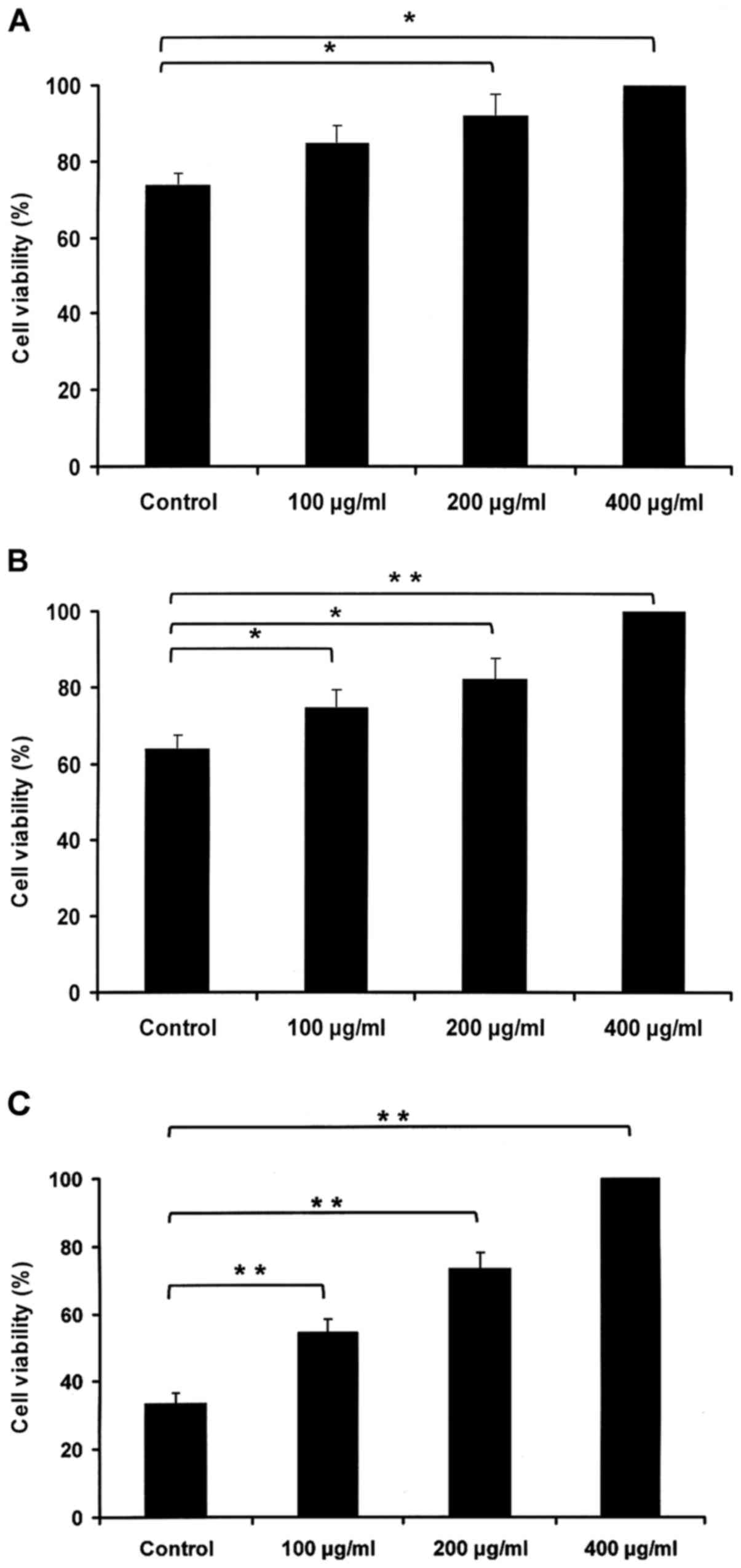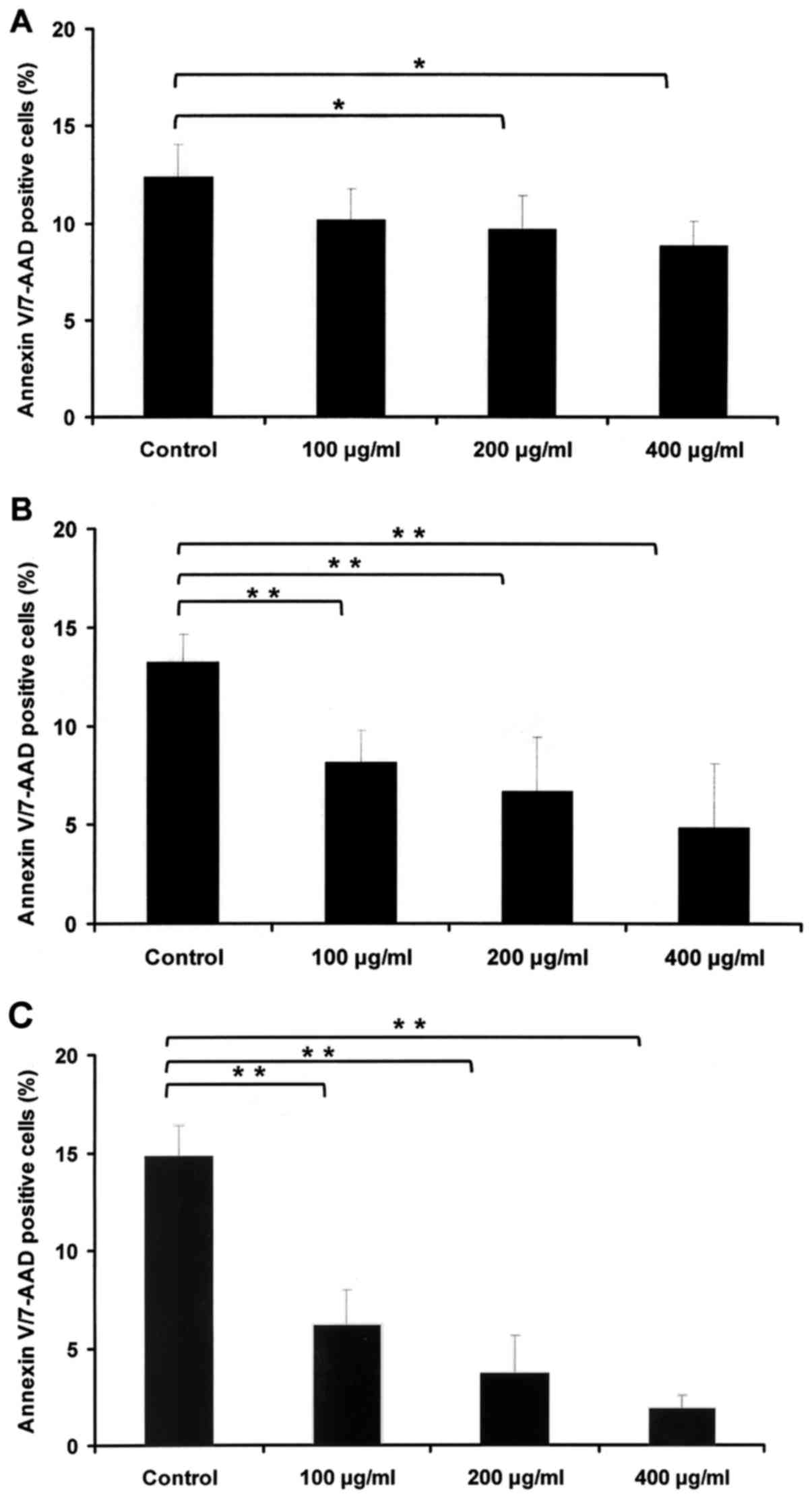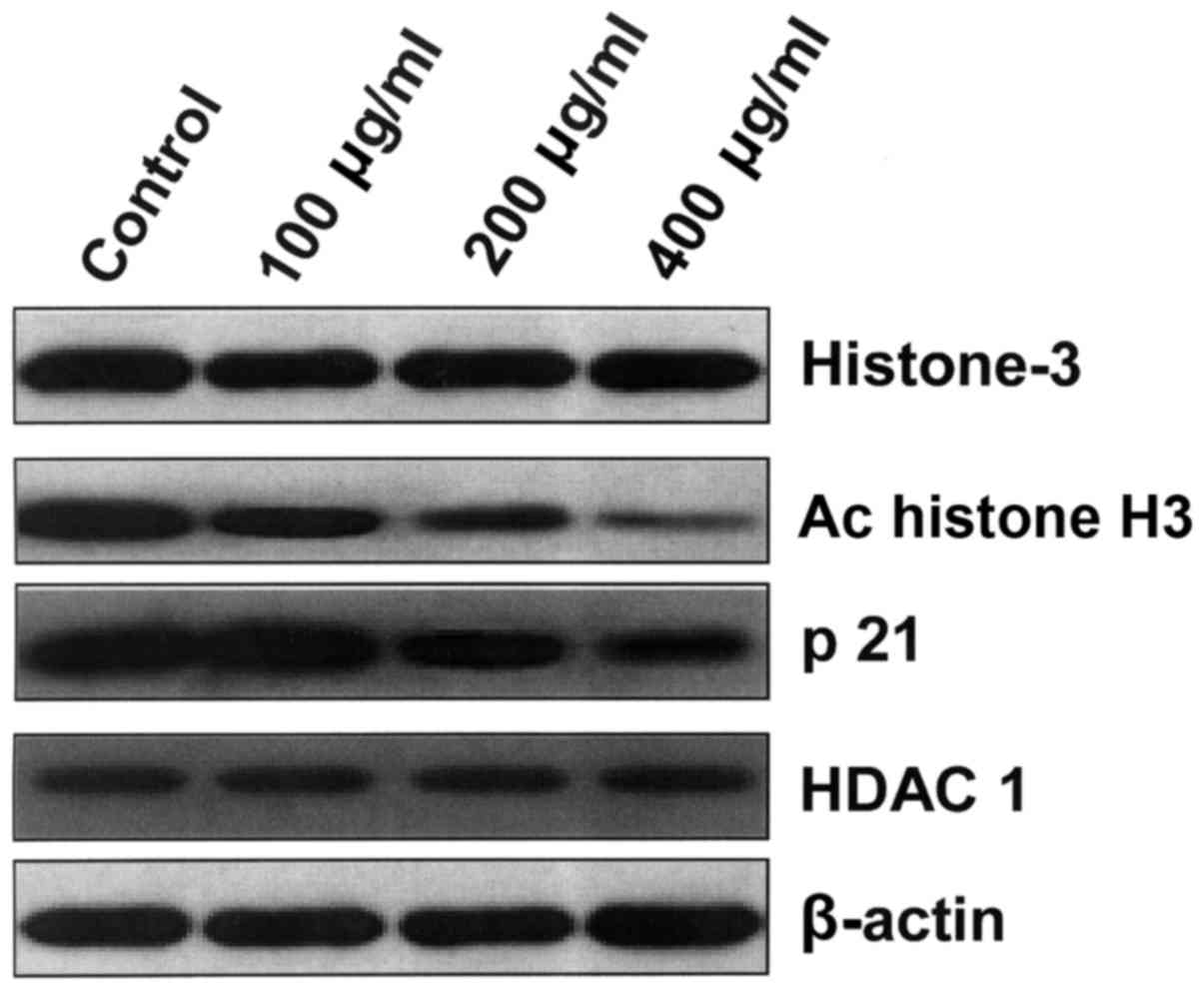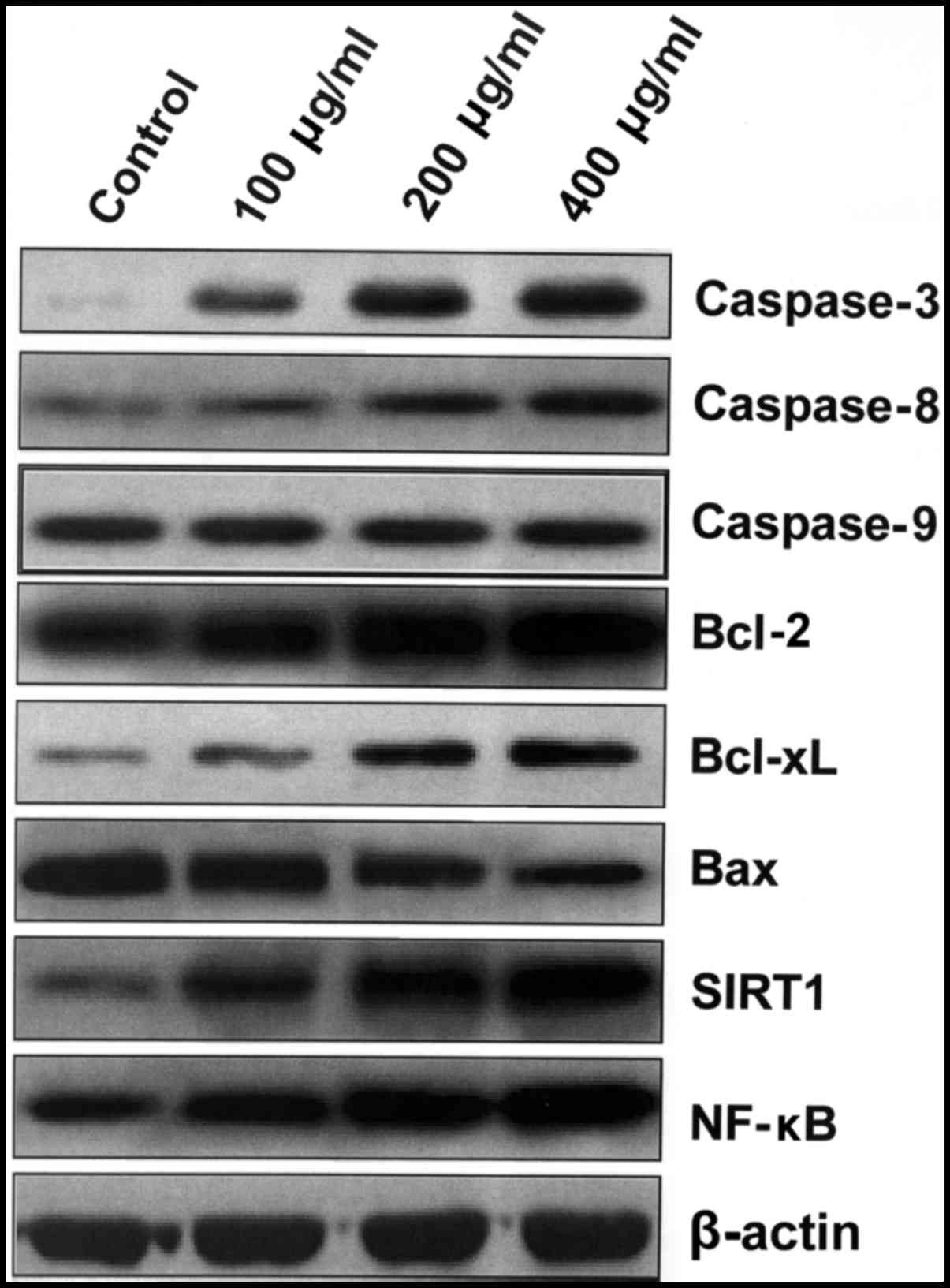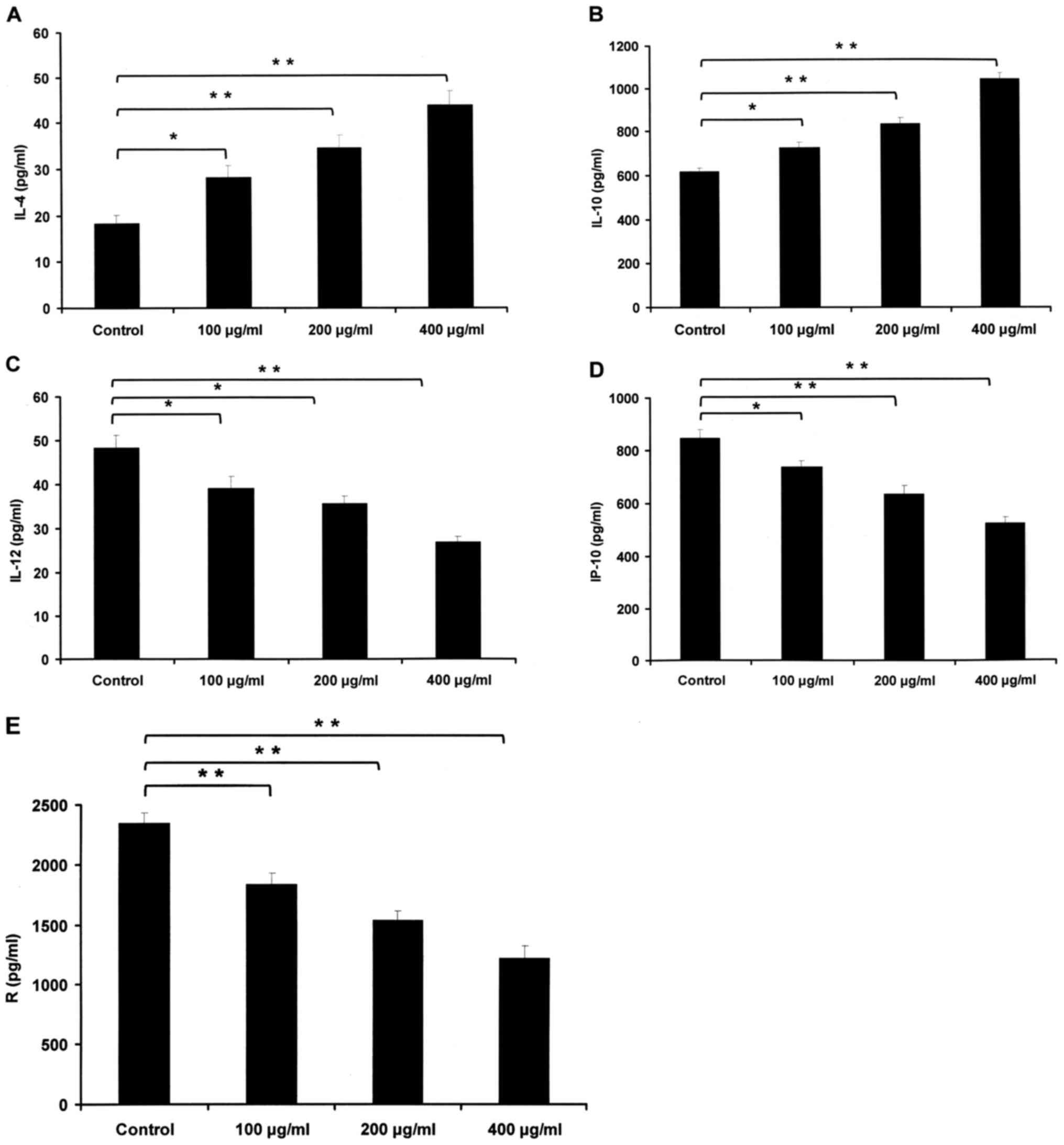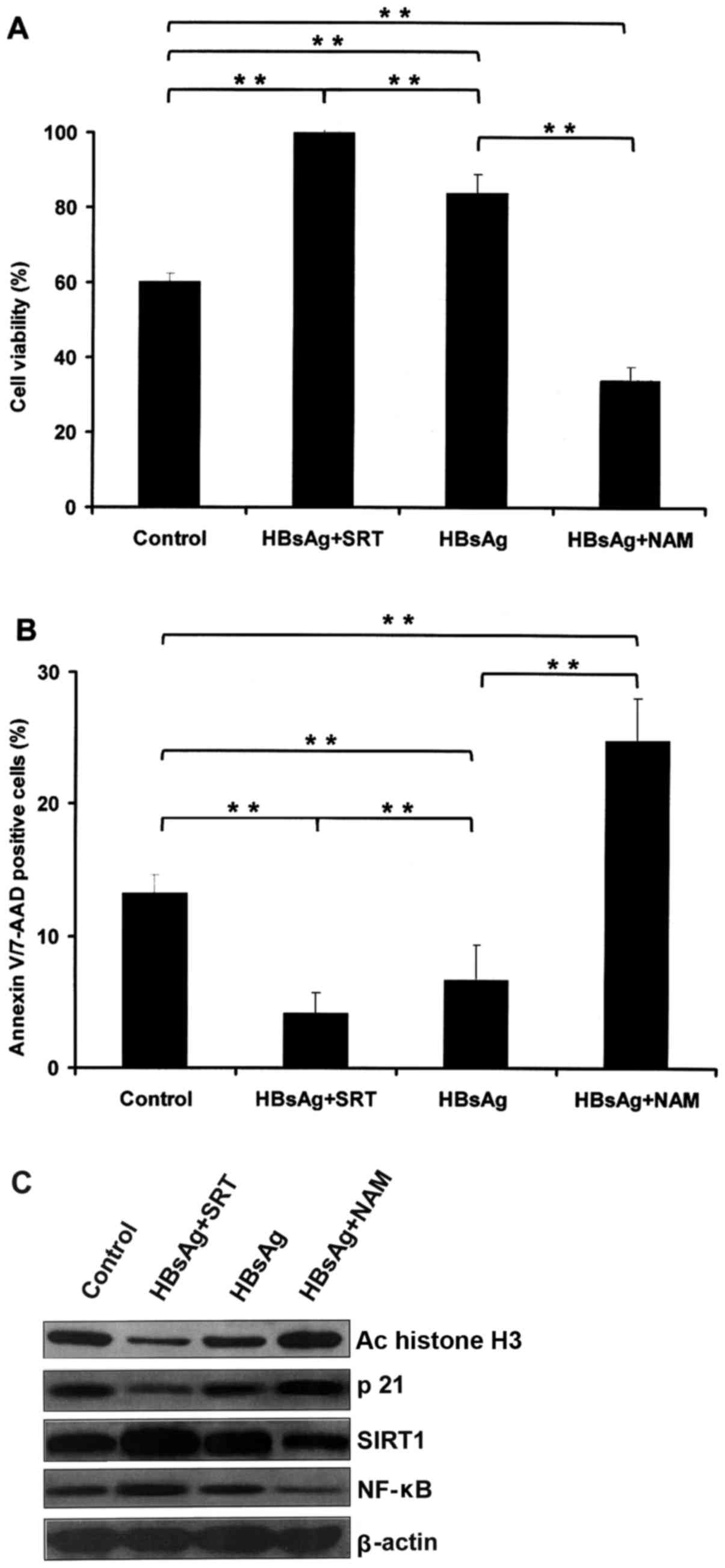Consecutive stimulation of HBsAg promotes the viability of the human B lymphoblastoid cell line IM‑9 through regulating the SIRT1‑NF‑κB pathway
Retraction in: /10.3892/ol.2023.13825
- Authors:
- Published online on: May 3, 2017 https://doi.org/10.3892/ol.2017.6114
- Pages: 433-440
Abstract
Introduction
Hepatitis B virus (HBV) causes acute and chronic infectious disease of the liver. Cirrhosis and liver cancer may eventually develop in these patients (1). An estimated 350 million individuals worldwide are currently experiencing chronic infection (2), and each year >750,000 people succumb to infectious diseases associated with HBV.
Sustained positive expression of hepatitis B surface antigen (HBsAg) is positively correlated with B-cell non-Hodgkin lymphoma (NHL) (3). According to epidemiological studies performed over the last decade, the risk of patients infected with HBV developing NHL was 1–2-fold higher than non-infected patients. Furthermore, HBV infection (HBsAg-negative, HBV DNA-positive) is also linked with the development of NHL (3). Although HBV infection may accompany other hematological malignancies, there is less available evidence to demonstrate the association between HBV and NHL (3).
As HBV potentially serves an etiological function in the development of lymphoma, it is necessary to explore whether HBV is also able to infect and replicate in lymphoid and hematopoietic cells. HBV is known to exist in extrahepatic sites (4). Furthermore, HBV nucleic acids have also been demonstrated to exist in the lymph nodes, spleen, kidneys, adrenal glands, gonads, thyroid gland and pancreas in patients with acute HBV infection (5).
In order to investigate this, it is necessary to determine whether the hematologic malignancy of HBV-positive patients with NHL regresses under antiviral therapy. A direct demonstration that HBV is involved in the development of NHL will offer a positive answer. In addition, if HBV contributes to lymphomagenesis, HBV vaccination will reduce the incidence of NHL, even though this impact may only be observed following a long time interval (3,6–8). A number of case-control studies concerning HBV with large cohorts have been published (9–11). In addition, a meta-analysis has reviewed these studies, and the pooled odds ratio demonstrated the rarity of the disorder, and was consistent with a significant association or benefit estimation to relative risk (RR) (12).
No adequate data concerning the potential association between major NHL subtypes and HBV is available to assess. A previous large-scale cohort study concerning South Korean people and their families from 1992–1995 has been performed (7). According to a previous study, positive expression of HBsAg resulted in a consistently increased risk of developing NHL during the whole 14 years of follow-up (7).
The relationship between HBV and NHL may have been underestimated due to patients with occult hepatitis infection. Occult HBV infection has been defined as patients who test HBsAg-negative but HBV DNA-positive in tissues, serum or a combination (13). HBV DNA may only exist in tissues in certain cases; hence, HBV DNA may be non-existent in the serum of patients with occult HBV. Although complete HBV elimination occurs in certain cases, this is considered to be rare at present (14,15). HBV DNA with replication ability may exist in the lymphocytes, liver or a combination for a long time. According to previous studies concerning the detection of HBV DNA in the serum, occult HBV infection further increased the relationship between NHL and HBsAg-positive chronic lymphocytic leukaemia (16–18). Certain individuals, who may be HBV DNA-positive in the lymphocytes, hepatocytes or a combination but negative in the serum, would potentially further influence the relationship between NHL and HBV infection. The mechanism of HBV-associated lymphoma remains indistinct, but the etiopathogenic function of HBV may help to construct a multifactorial model for lymphomagenesis. The aim of the present study was to answer these unresolved questions.
Materials and methods
Cell culture
The human peripheral lymphoblastoid cell line IM-9 (CCL-159) was obtained from the American Type Culture Collection (Manassas, VA, USA). This cell line resulted from human B lymphocytes without tumor features that were immortalized with the Epstein-Barr virus, and are useful for genetic or functional research as they preserve the genetic characteristics of the lymphocyte B donor (19–21). The IM-9 cells were cultured in RPMI-1640 medium (Thermo Fisher Scientific, Inc., Waltham, MA, USA) with 15% fetal bovine serum (Gibco; Thermo Fisher Scientific, Inc.), 4-(2-hydroxyethyl)-1-piperazineethanesulfonic acid and glutamine (Biowest, Nuaillé, France), 100 µg/ml streptomycin and 100 U/ml penicillin (Thermo Fisher Scientific, Inc.). Cells were cultured in a humidified 5% CO2 atmosphere at 37°C. Incubations with different concentrations of HBsAg (100, 200 and 400 µg/ml) were performed under these conditions. DMSO (0.1%) was used as control.
Regents
HBsAg (Recombinant Hepatitis B Surface Antigen, Adw; cat. no. hbs-872; lot no. 713PADW16) was purchased from ProSpec-Tany TechnoGene, Ltd. (Rehovot, Israel). Acetylated histone H3 (cat. no. 8173; dilution, 1:2,000), histone 3 (cat. no. 2632; dilution, 1:2,000), p21 (cat. no. 2947; dilution, 1:2,000), sirtuin 1 (SIRT1; cat. no. 8469; dilution, 1:3,000), nuclear factor-κB (NF-κB; cat. no. 4882; dilution, 1:3,000), caspase-3 (cat. no. 9662; dilution, 1:2,500), caspase-8 (cat. no. 8592; dilution, 1:2,500), caspase-9 (cat. no. 9509; dilution, 1:2,500), histone deacetylase 1 (HDAC1; cat. no. 34589; dilution, 1:2,000), B-cell lymphoma-extra-large (Bcl-xL; cat. no. 2764; dilution, 1:2,000), B-cell lymphoma 2 (Bcl-2; cat. no. 15071; dilution, 1:2,000) and BCL2 associated X (Bax; cat. no. 5023; dilution, 1:2,500) antibodies were all obtained from Cell Signaling Technology, Inc. (Danvers, MA, USA). β-actin antibodies (cat. no. SC-47778; dilution, 1:5,000) were obtained from Santa Cruz Biotechnology, Inc. (Dallas, TX, USA). Horseradish peroxidase-conjugated secondary antibodies (goat anti-mouse immunoglobulin; cat. no. 31430; dilution, 1:8,000) were acquired from GE Healthcare Life Sciences (Chalfont, UK). The activator of SIRT1, SRT1720 (SRT), was purchased from Calbiochem-Novabiochem Corporation (San Diego, CA, USA), and the inhibitor of SIRT1, nicotinamide (NAM), was obtained from Sigma-Aldrich (Merck KgaA, Darmstadt, Germany).
Western blotting
A lysis buffer [0.1% SDS, 50 mM Tris (pH 8), 150 mM NaCl, 0.5% sodium deoxycholate, 0.02% NaN3 and 1% NP-40] containing a protease inhibitor cocktail (Roche Applied Science, Penzberg, Germany) and 1 mM phenylmethylsulfonyl fluoride was used to extract lysates from cells. A Bradford assay with Coomassie Plus Protein Reagent (Thermo Fisher Scientific, Inc.) was used to measure protein concentrations. A Biolad system was used to perform western blotting assays. Protein (50 µg) was loaded in each well of a 12% gel for electrophoresis, then transferred to a polyvinylidene fluoride membrane. Non-specific binding was blocked with 1X TBST containing 5% dry skimmed milk, with agitation, at room temperature for 1 h. The membrane was incubated with the primary antibody solution overnight at 4°C, then with the secondary antibody, with gentle agitation, for 1 h at room temperature. The protein bands were detected using an enhanced chemiluminescence reagent, purchased from GE Healthcare Life Sciences, to expose X-ray film.
In vitro viability assay
Cells (0.5×106 cells/ml) were plated in 6-, 12-, and 24-well plates. Cell viability was assessed using the nonradioactive MTS cell viability assay (22). Briefly, 20 µl Cell Titer 96 AQueous One Solution reagent and 80 µl cell suspension were cultured in 96-well plates for 1 h in a 5% CO2 atmosphere at 37°C. Formazan absorbance was then measured at 490 nm on a Quant plate reader assembled with KC4 software (Biotek Instruments, Inc., Winooski, VT, USA). The measurement was repeated in triplicate and the means were obtained.
Detection of apoptotic cells with flow cytometry
Using Annexin V staining, fluorescence-activated cells sorting analysis was performed following treatment of the cells with HBsAg (100, 200 and 400 µg/ml; incubated at 37°C for 48 h) and/or SRT (10 µM; incubated at 37°C for 12 h) or NAM (300 µM; incubated at 37°C for 1 h). DMSO was used as negative control. Cells were harvested and stained with Annexin V and 7-aminoactinomycin D from an Annexin V-Fluorescein Isothiocyanate Apoptosis Detection kit (BD Biosciences, Franklin Lakes, NJ, USA) according to the manufacturer's protocol. Flow cytometry was performed using a FACScan flow cytometer (BD Biosciences) and FlowJo software version 10.2 (FlowJo LLC, Ashland, OR, USA).
ELISA
IM-9 cells were cultured, as previously described, with 100, 200 or 400 µg/ml HBsAg for 24–72 h. DMSO (0.1%) was used as a negative control. The cells were then centrifuged at 3,000 × g for 10 min in room temperature and the supernatant collected. The Human Thirty-Plex Antibody Bead kit (Invitrogen; Thermo Fisher Scientific, Inc.) was then used according to the manufacturer's protocol to detect C-X-C motif chemokine 10 (CXCL10, also known as IP-10), interleukin (IL)-4, −10 and −12 and C-C motif chemokine ligand 5 (CCL5, also known as RANTES) levels. The assay was performed in triplicate.
Statistical analysis
Normally distributed, continuous variables were represented as the mean ± standard deviation. Comparisons of quantitative data between groups were performed using a paired Student's t-tests or analysis of variance. Abnormally distributed data were analyzed using Kruskal-Wallis tests. All statistical analyses were conducted using SPSS software version 18.0 (SPSS, Inc., Chicago, IL, USA). P<0.05 was considered to indicate a statistically significant difference.
Results
HBsAg promotes IM-9 cell viability in a dose- and time-dependent manner
To assess the impact of HBsAg in the IM-9 cell line in vitro, cell viability was measured using the MTS assay. IM-9 cells were cultured with PBS or HBsAg (100, 200 and 400 µg/ml) for 24 (Fig. 1A), 48 (Fig. 1B) and 72 h (Fig. 1C). The results revealed that the HBsAg-induced increase in viability relied on dose and time.
HBsAg reduces apoptosis in a dose- and time-dependent manner
To assess the in vitro impact of HBsAg in IM-9 cell lines, its effect on apoptosis was measured. IM-9 cells were cultured with PBS or HBsAg (100, 200 and 400 µg/ml) for 24 (Fig. 2A), 48 (Fig. 2B) and 72 h (Fig. 2C). Cell apoptosis was subsequently determined by Annexin V/7-aminoactinomycin D staining and fluorescence activated cell sorting analysis, which revealed that the HBsAg-induced decrease in apoptosis rate relied on dose and time.
HBsAg decreases the expression of histone H3 acetylation and p21
IM-9 cells were cultured with HBsAg for 48 h, and then western blotting was performed. A general characteristic of histone deacetylases is to decrease the expression of carcinoma suppressor genes by deacetylating histones, including p21 (23). Therefore, the impact of HBsAg on p21 expression and histone H3 acetylation was measured. Acetylation of histone H3 and p21 expression was observed at each concentration at 48 h. HDAC1 expression was measured as a positive control. The results revealed that HBsAg decreased the expression of p21 and histone H3 acetylation in a dose-dependent manner (Fig. 3).
HBsAg upregulates the expression of anti-apoptotic Bcl-2 family proteins, and inactivates the intrinsic apoptosis pathway
Expression levels of components of the apoptosis pathway were also analyzed. IM-9 cells were cultured with HBsAg for 48 h and western blotting was performed. Caspase-3 and −8 expression increased following treatment with HBsAg (Fig. 4). Furthermore, HBsAg treatment resulted in the upregulation of SIRT1 and NF-κB in a dose-dependent manner. However, the level of caspase-9 remained unchanged, implying that the intrinsic apoptosis pathway contributed to the inhibition of the apoptosis process induced by HBsAg (Fig. 4). HBsAg also upregulated the expression of anti-apoptotic Bcl-xL and Bcl-2 proteins, and inactivated the intrinsic apoptosis pathway by downregulating Bax and increasing the expression of SIRT1 and NF-κB (Fig. 4).
HBsAg affects the expression levels of multiple chemokines and cytokines
NHL with dysregulated cytokines may cause the immune system to fail to respond to carcinoma cells (24). Thus, the expression levels of multiple chemokines and cytokines were detected with a Human Thirty-Plex Antibody Bead kit in IM-9 cells treated with or without 100, 200 or 400 µg/ml HBsAg for 48 h to examine whether HBsAg influenced production of these cytokines. The expression levels of cytokine IL-12, chemokines IP-10 and RANTES, which contribute to Th1 cell differentiation and recruitment, were all significantly decreased following treatment with HBsAg. IP-10 is a ligand for C-X-C motif chemokine receptor 2 and RANTES is a ligand for C-C motif chemokine receptor (CCR)5 and CCR3. IL-10, which is a pivotal growth factor of NHL cancer cells, increased significantly, as did IL-4, which is necessary for Th2 cell differentiation. HBsAg elevated the levels of IL-10, and IL-4, but reduced the levels of IP-10, IL-12, and RANTES (Fig. 5).
Inhibition of SIRT1 suppresses the effects induced by HBsAg
IM-9 cells were cultured with PBS or HBsAg (200 µg/ml) for 48 h, and then treated with SRT (10 µM) or NAM (10 mM) for a further 48 h (25). Cell viability was determined, and the HBsAg-induced increase of cell viability was demonstrated to be promoted by SRT and inhibited by NAM (Fig. 6A). The rate of cell apoptosis was then determined, which revealed that the anti-apoptosis effect of HBsAg was promoted by SRT and inhibited by NAM (Fig. 6B). The downregulation of histone H3 acetylation and p21 induced by HBsAg was increased by SRT and inhibited by NAM (Fig. 6C). Furthermore, the upregulation of SIRT1 and NF-κB induced by HBsAg was increased by SRT and inhibited by NAM (Fig. 6C).
Discussion
HBV is well-known to be associated with NHL. However, whether these associations reveal causal relationships remains open to discussion. There are three possibilities that may account for these relationships. First, as a result of that the carcinoma itself directly suppressing the immune system, the risk of viral infection or reactivation increases. Unfortunately, this explanation lacks evidence. According to a number of studies concerning patients with newly diagnosed disease, significant immune deficiency was not discovered prior to any treatment intervention (26,27). Secondly, another unknown virus sharing a similar transmission mechanism with the hepatitis virus may represent the actual oncogenic stimulus. Due to the lack of evidence, this hypothesis remains unclarified. The third possibility is that hepatitis viruses serve an oncogenic function in the development of NHL. This possibility and applicable mechanisms are explored in the next section. In fact, the association between NHL and HBV is not strong, because the RR is within the 2–3 range. This is less than the relationship between HBV infection and HCC (12). For example, one of the highest RR of HBV carriers for HCC is ~200 (28).
As discussed in a previous publication, the causal association between HBV and NHL has not been conclusively demonstrated, but the evidence suggests the existence of a positive relationship between them (6). This causal relationship may be HBV-driven. The first potential mechanism is that HBV infection directly leads to the development of carcinoma. HBV is known to infect and replicate within lymphocytes, but although infection may bring about neoplastic transformation, this is not the inevitable result of viral replication. HBV that integrate in the host genome may result in high expression of cellular oncogenes or low expression of tumor suppressor genes (29,30). The second potential mechanism is similar to a commonly explained model of HCV-driven lymphomagenesis (6). This is known as chronic antigenic stimulation. This mechanism does not need to involve the infection of lymphocytes. With the infection of hepatocytes there is sufficient infective virus and viral antigens to support chronic, antigen-driven proliferation and stimulation of lymphocytes. This is likely to autonomously induce neoplastic transformation and proliferation, because chronic antigenic stimulation may lead to a predisposition to genetic aberrations, induction of double stranded DNA breaks and translocation or overexpression of proto-oncogenes (3). However, whether HBV is merely involved in the initial stages of neoplastic or contributes to continuous neoplastic viability remains to be demonstrated.
In the present study, the human peripheral lymphoblastoid cell line, IM-9, was cultured with HBsAg to imitate chronic antigenic stimulation. HBsAg was demonstrated to promote cell viability and to reduce apoptosis in a time- and dose-dependent manner in IM-9 cells. The underlying mechanism was the dose-dependent decrease in histone H3 acetylation and p21 expression. Furthermore, HBsAg upregulated the expression of anti-apoptotic Bcl-2 family proteins, and inactivated the intrinsic apoptosis pathway. Caspase-3 and −8 increased following treatment with HBsAg. HBsAg also induced the upregulation of SIRT1 and NF-κB in dose-dependent manner, and induced the increased expression of the anti-apoptotic Bcl-xL and Bcl-2 proteins. In addition, HBsAg inactivated the intrinsic apoptosis pathway through upregulating the expression of NF-κB and SIRT1 and decreasing the expression of Bax.
Dysregulated cytokines in NHL may cause the immune system to fail to respond against carcinoma cells (24). A Human Thirty-Plex Bead kit was used to analyze the impact of HBsAg on cytokine and chemokine production. The results demonstrated that HBsAg regulated the level of multiple chemokines and cytokines, including IL-4, IL-10, IL-12, IP-10, and RANTES. HBsAg increased levels of IL-4 and IL-10 while it decreased levels of RANTES, IP-10 and IL-12.
Mammalian SIRT1, the ortholog of yeast Sir2, is a class III histone deacetylase whose activation is dependent on nicotinamide adenine dinucleotide in the nucleus (31,32). It deacetylates histones and a large number of non-histone substrates, including the forkhead box class O family (33–35). High expression of SIRT1 is often detected in prostate cancer, glioblastoma and primary colon cancer, and it inactivates proteins that participate in DNA damage repair and tumor suppression (36). Consequently, SIRT1 is considered to be a tumor promoter.
In the present study, IM-9 cells were cultured with PBS or HBsAg (200 µg/ml) for 48 h, and then treated with activator of SRT or NAM for a further 48 h (25). Cell viability was then determined, and the data revealed that the increase in cell viability induced by HBsAg was promoted by SRT and inhibited by NAM. Cell apoptosis levels were then determined, and the anti-apoptotic effect of HBsAg was promoted by SRT and inhibited by NAM. The downregulation of histone H3 acetylation and p21 expression induced by HBsAg was increased by SRT and inhibited by NAM. Furthermore, the upregulation of SIRT1 and NF-κB induced by HBsAg was increased by SRT and inhibited by NAM.
In conclusion, HBsAg was demonstrated to induce an anti-apoptotic activity effect in IM-9 cells via a number of mechanisms, including promotion of cell viability, inhibition of apoptosis, regulation of chemokines and cytokines, alteration of SIRT1 and NF-κB expression and a decrease of histone H3 acetylation. Consecutive stimulation with HBsAg promoted the viability of a human B lymphoblastoid cell line, IM-9, through regulating the SIRT1-NF-κB pathway. This may be a potential mechanism underlying HBV-associated NHL.
Acknowledgements
The present study was supported by grants from the National Natural Science Foundation of China (grant no. 30600524), the National Natural Science Foundation of Hainan Province, China (grant no. 817351) and the Clinical Support and Scientific Research Projects of Chinese People's Liberation Army General Hospital (grant no. 2013 FC-ZHCG-1001).
References
|
Kew MC: Epidemiology of chronic hepatitis B virus infection, hepatocellular carcinoma and hepatitis B virus-induced hepatocellular carcinoma. Pathol Biol (Paris). 58:273–277. 2010. View Article : Google Scholar : PubMed/NCBI | |
|
Mizuguchi Y, Takizawa T and Uchida E: Host cellular microRNA involvement in the control of hepatitis B virus gene expression and replication. World J Hepatol. 7:696–702. 2015. View Article : Google Scholar : PubMed/NCBI | |
|
Marcucci F, Spada E, Mele A, Caserta CA and Pulsoni A: The association of hepatitis B virus infection with B-cell non-Hodgkin lymphoma-a review. Am J Blood Res. 2:18–28. 2012.PubMed/NCBI | |
|
Ciesek S, Helfritz FA, Lehmann U, Becker T, Strassburg CP, Neipp M, Ciner A, Fytili P, Tillmann HL, Manns MP and Wedemeyer H: Persistence of occult hepatitis B after removal of the hepatitis B virus-infected liver. J Infect Dis. 197:355–360. 2008. View Article : Google Scholar : PubMed/NCBI | |
|
Yoffe B, Burns DK, Bhatt HS and Combes B: Extrahepatic hepatitis B virus DNA sequences in patients with acute hepatitis B infection. Hepatology. 12:187–192. 1990. View Article : Google Scholar : PubMed/NCBI | |
|
Marcucci F and Mele A: Hepatitis viruses and non-Hodgkin lymphoma: Epidemiology, mechanisms of tumorigenesis, and therapeutic opportunities. Blood. 117:1782–1789. 2011. View Article : Google Scholar | |
|
Engels EA, Cho ER and Jee SH: Hepatitis B virus infection and risk of non-Hodgkin lymphoma in South Korea: A cohort study. Lancet Oncol. 11:827–834. 2010. View Article : Google Scholar : PubMed/NCBI | |
|
Yi HZ, Chen JJ, Cen H, Yan W and Tan XH: Association between infection of hepatitis B virus and onset risk of B-cell non-Hodgkin's lymphoma: A systematic review and a meta-analysis. Med Oncol. 31:842014. View Article : Google Scholar : PubMed/NCBI | |
|
Galun E, Ilan Y, Livni N, Ketzinel M, Nahor O, Pizov G, Nagler A, Eid A, Rivkind A, Laster M, et al: Hepatitis B virus infection associated with hematopoietic tumors. Am J Pathol. 145:1001–1007. 1994.PubMed/NCBI | |
|
Kim JH, Bang YJ, Park BJ, Yoo T, Kim CW, Kim TY, Heo DS, Lee HS and Kim NK: Hepatitis B virus infection and B-cell non-Hodgkin's lymphoma in a hepatitis B endemic area: A case-control study. Jpn J Cancer Res. 93:471–477. 2002. View Article : Google Scholar : PubMed/NCBI | |
|
Marcucci F, Mele A, Spada E, Candido A, Bianco E, Pulsoni A, Chionne P, Madonna E, Cotichini R, Barbui A, et al: High prevalence of hepatitis B virus infection in B cell non-Hodgkin lymphoma. Haematologica. 91:554–557. 2006.PubMed/NCBI | |
|
Nath A, Agarwal R, Malhotra P and Varma S: Prevalence of hepatitis B virus infection in non-Hodgkin's lymphoma. A systematic review and meta-analysis. Intern Med J. 40:633–641. 2010. View Article : Google Scholar : PubMed/NCBI | |
|
Bréchot C, Thiers V, Kremsdorf D, Nalpas B, Pol S and Paterlini-Bréchot P: Persistent hepatitis B virus infection in subjects without hepatitis B surface antigen: Clinically significant or purely ‘occult’? Hepatology. 34:194–203. 2001. View Article : Google Scholar : PubMed/NCBI | |
|
Yuki N, Nagaoka T, Yamashiro M, Mochizuki K, Kaneko A, Yamamoto K, Omura M, Hikiji K and Kato M: Long-term histologic and virologic outcomes of acute self-limited hepatitis B. Hepatology. 37:1172–1179. 2003. View Article : Google Scholar : PubMed/NCBI | |
|
Rehermann B, Ferrari C, Pasquinelli C and Chisari FV: The hepatitis B virus persists for decades after patients' recovery from acute viral hepatitis despite active maintenance of a cytotoxic T-lymphocyte response. Nat Med. 2:1104–1108. 1996. View Article : Google Scholar : PubMed/NCBI | |
|
Chen MH, Hsiao LT, Chiou TJ, Liu JH, Gau JP, Teng HW, Wang WS, Chao TC, Yen CC and Chen PM: High prevalence of occult hepatitis B virus infection in patients with B-cell non-Hodgkin's lymphoma. Ann Hematol. 87:475–480. 2008. View Article : Google Scholar : PubMed/NCBI | |
|
Rossi D, Sala L, Minisini R, Fabris C, Falleti E, Cerri M, Burlone ME, Toniutto P, Gaidano G and Pirisi M: Occult hepatitis B virus infection of peripheral blood mononuclear cells among treatment-naive patients with chronic lymphocytic leukemia. Leuk Lymphoma. 50:604–611. 2009. View Article : Google Scholar : PubMed/NCBI | |
|
Wang F, Xu RH, Han B, Shi YX, Luo HY, Jiang WQ, Lin TY, Huang HQ, Xia ZJ and Guan ZZ: High incidence of hepatitis B virus infection in B-cell subtype non-Hodgkin lymphoma compared with other cancers. Cancer. 109:1360–1364. 2007. View Article : Google Scholar : PubMed/NCBI | |
|
Sie L, Loong S and Tan EK: Utility of lymphoblastoid cell lines. J Neurosci Res. 87:1953–1959. 2009. View Article : Google Scholar : PubMed/NCBI | |
|
Sugimoto M, Tahara H, Ide T and Furuichi Y: Steps involved in immortalization and tumorigenesis in human B-lymphoblastoid cell lines transformed by Epstein-Barr virus. Cancer Res. 64:3361–3364. 2004. View Article : Google Scholar : PubMed/NCBI | |
|
Hussain T and Mulherkar R: Lymphoblastoid cell lines: A continuous in vitro source of cells to study carcinogen sensitivity and DNA repair. Int J Mol Cell Med. 1:75–87. 2012.PubMed/NCBI | |
|
Georgakis GV, Li Y, Rassidakis GZ, Martinez-Valdez H, Medeiros LJ and Younes A: Inhibition of heat shock protein 90 function by 17-allylamino-17-demethoxy-geldanamycin in Hodgkin's lymphoma cells down-regulates Akt kinase, dephosphorylates extracellular signal-regulated kinase, and induces cell cycle arrest and cell death. Clin Cancer Res. 12:584–590. 2006. View Article : Google Scholar : PubMed/NCBI | |
|
Gui CY, Ngo L, Xu WS, Richon VM and Marks PA: Histone deacetylase (HDAC) inhibitor activation of p21WAF1 involves changes in promoter-associated proteins, including HDAC1. Proc Natl Acad Sci USA. 101:pp. 1241–1246. 2004; View Article : Google Scholar : PubMed/NCBI | |
|
Maggio E, van den Berg A, Diepstra A, Kluiver J, Visser L and Poppema S: Chemokines, cytokines and their receptors in Hodgkin's lymphoma cell lines and tissues. Ann Onc. 13 Suppl 1:52–56. 2002. View Article : Google Scholar | |
|
Côté CD, Rasmussen BA, Duca FA, Zadeh-Tahmasebi M, Baur JA, Daljeet M, Breen DM, Filippi BM and Lam TK: Resveratrol activates duodenal Sirt1 to reverse insulin resistance in rats through a neuronal network. Nat Med. 21:498–505. 2015. View Article : Google Scholar : PubMed/NCBI | |
|
Simms-Waldrip TR, Sunkersett G, Coughlin LA, Savani MR, Arana C, Kim J, Kim M, Zhan X, Greenberg DE, Xie Y, et al: Antibiotic-induced depletion of anti-inflammatory clostridia is associated with the development of graft-versus-host disease in pediatric stem cell transplantation patients. Biol Blood Marrow Transplant. 23:820–829. 2017. View Article : Google Scholar : PubMed/NCBI | |
|
Jain N, Oswal N, Chawla AS, Agrawal T, Biswas M, Vrati S, Rath S, George A, Bal V and Medigeshi GR: CD8 T cells protect adult naive mice from JEV-induced morbidity via lytic function. PLoS Negl Trop Dis. 11:e00053292017. View Article : Google Scholar : PubMed/NCBI | |
|
Feitelson MA and Duan LX: Hepatitis B virus × antigen in the pathogenesis of chronic infections and the development of hepatocellular carcinoma. Am J Pathol. 150:1141–1157. 1997.PubMed/NCBI | |
|
Natoli G, Avantaggiati ML, Chirillo P, Puri PL, Ianni A, Balsano C and Levrero M: Ras- and Raf-dependent activation of c-jun transcriptional activity by the hepatitis B virus transactivator pX. Oncogene. 9:2837–2843. 1994.PubMed/NCBI | |
|
Wang XW, Gibson MK, Vermeulen W, Yeh H, Forrester K, Stürzbecher HW, Hoeijmakers JH and Harris CC: Abrogation of p53-induced apoptosis by the hepatitis B virus X gene. Cancer Res. 55:6012–6016. 1995.PubMed/NCBI | |
|
Imai S, Armstrong CM, Kaeberlein M and Guarente L: Transcriptional silencing and longevity protein Sir2 is an NAD-dependent histone deacetylase. Nature. 403:795–800. 2000. View Article : Google Scholar : PubMed/NCBI | |
|
Smith JS, Brachmann CB, Celic I, Kenna MA, Muhammad S, Starai VJ, Avalos JL, Escalante-Semerena JC, Grubmeyer C, Wolberger C and Boeke JD: A phylogenetically conserved NAD+-dependent protein deacetylase activity in the Sir2 protein family. Proc Natl Acad Sci USA. 97:pp. 6658–6663. 2000; View Article : Google Scholar : PubMed/NCBI | |
|
Huang H and Tindall DJ: Dynamic FoxO transcription factors. J Cell Sci. 120:2479–2487. 2007. View Article : Google Scholar : PubMed/NCBI | |
|
Salminen A, Kauppinen A, Suuronen T and Kaarniranta K: SIRT1 longevity factor suppresses NF-kappaB-driven immune responses: Regulation of aging via NF-kappaB acetylation? Bioessays. 30:939–942. 2008. View Article : Google Scholar : PubMed/NCBI | |
|
van Leeuwen I and Lain S: Sirtuins and p53. Adv Cancer Res. 102:171–195. 2009. View Article : Google Scholar : PubMed/NCBI | |
|
Deng CX: SIRT1, is it a tumor promoter or tumor suppressor? Int J Biol Sci. 5:147–152. 2009. View Article : Google Scholar : PubMed/NCBI |



